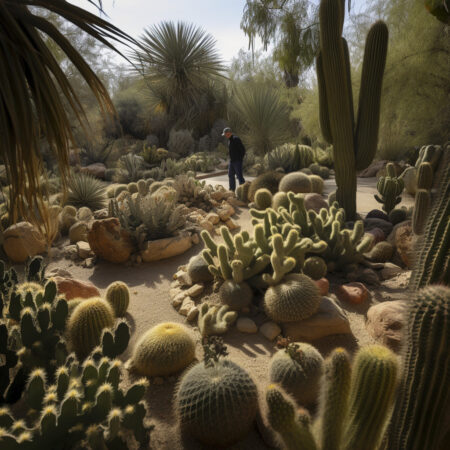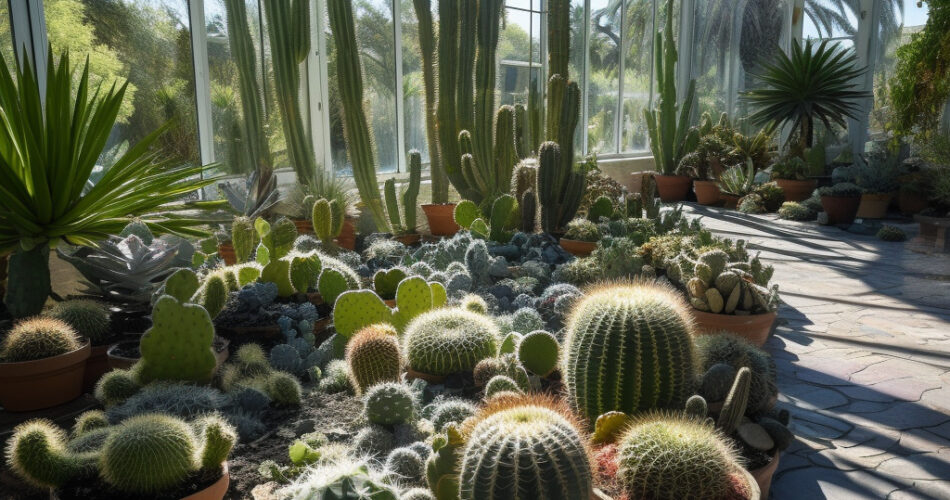Key Takeaways:
- Historical cactus gardens have preserved and showcased the diversity of cacti from around the world.
- Iconic cactus gardens like Huntington Desert Garden and Royal Botanic Gardens at Kew have significant cactus collections.
- Historical cactus gardens contribute to plant diversity understanding and conservation efforts.
- Cactus conservatories preserve rare and endangered cactus species and promote public engagement.
- Conservatories like Desert Botanical Garden actively contribute to conservation efforts and raise awareness about threats to cacti.
- Famous historical cactus gardens offer diverse cactus species and architectural delights.
- Cactus gardens reflect cultural and historical significance, such as Oaxaca Ethnobotanical Garden and Cactario di Altamura.
- When visiting cactus gardens, plan your route, check blooming periods, and respect the plants and their surroundings.
When one thinks of the desert, images of vast stretches of barren land may come to mind. However, hidden within these arid landscapes lie living treasures that have fascinated botanists, horticulturists, and nature enthusiasts for centuries – cacti. These resilient plants have adapted to survive in the harshest of conditions, making them a symbol of endurance and beauty.
1. Unveiling the Natural Wonders: Exploring the Famous Historical Cactus Gardens
Historical cactus gardens have been instrumental in preserving and showcasing the rich diversity of cacti from around the world. These botanical delights offer visitors a unique opportunity to witness the beauty of these remarkable plants up close. Let’s delve into the origins of historical cactus gardens and explore some iconic gardens from different corners of the globe.
1.1 The Remarkable Origins of Historical Cactus Gardens
The history of cactus gardens dates back to the colonial era when explorers encountered these fascinating plants during their expeditions. It was the curiosity and admiration for these resilient plants that led to the establishment of the first historical cactus gardens. These early gardens aimed to showcase the exotic and rare cacti collected from various parts of the world.
One of the earliest cactus gardens was created in the late 18th century in Mexico City, known as the Cactus Garden of Xochimilco. This garden played a crucial role in introducing cacti to a wider audience and fostering an appreciation for these unique plants.
1.2 Iconic Cactus Gardens Around the World
Throughout history, numerous iconic cactus gardens have gained recognition for their stunning displays and contributions to cactus conservation. One such garden is the Huntington Desert Garden located in San Marino, California. Spanning over 10 acres, this garden features one of the most significant collections of desert plants in the world, including an extensive array of cacti.
In Europe, the Royal Botanic Gardens at Kew, London, boasts a remarkable cactus collection within its Princess of Wales Conservatory. This collection showcases various species from different habitats, allowing visitors to admire the diversity of cacti from around the world.
1.3 Understanding the Importance of Historical Cactus Gardens
Historical cactus gardens play a vital role in the conservation of these remarkable plants. By meticulously cultivating and displaying a wide variety of cacti, these gardens contribute to our understanding of plant diversity and promote conservation efforts.
Not only do historical cactus gardens serve as educational resources, but they also provide valuable research opportunities for scientists and botanists. By studying these plants in controlled environments, researchers can further our knowledge of cacti, their adaptations, and their potential medicinal properties.
2. Immersing Yourself in the Botanical Beauty: The Role of Cactus Conservatories
While historical cactus gardens provide an avenue for exploring the diversity of cacti, cactus conservatories take this experience to another level. These specialized facilities are dedicated to the preservation and cultivation of rare and endangered cactus species.
2.1 The Purpose and Function
Cactus conservatories play a crucial role in maintaining the genetic diversity of cacti and safeguarding these plants for future generations. These facilities often collaborate with other botanical institutions and conservation organizations to exchange knowledge and propagate endangered cactus species.
In addition to their conservation efforts, cactus conservatories promote public engagement by providing opportunities for visitors to learn about these extraordinary plants. Through guided tours, educational workshops, and interactive exhibits, visitors can gain a deeper appreciation for the ecological importance of cacti.
2.2 Discovering Rare and Endangered Cactus Species
Cactus conservatories house rare and endangered cactus species, many of which are on the brink of extinction due to habitat loss and illegal collection. These facilities serve as living gene banks, preserving these species and conducting research to develop successful conservation strategies.
One notable cactus conservatory is the Desert Botanical Garden in Phoenix, Arizona. This facility is renowned for its efforts in conserving native cacti, including the iconic Saguaro cactus, while also showcasing the beauty and diversity of desert plants.
2.3 The Conservation Efforts
Cactus conservatories actively contribute to conservation efforts through seed banking, captive breeding programs, and habitat restoration initiatives. They collaborate with botanists, horticulturists, and local communities to implement sustainable practices and protect cactus species in their natural habitats.
These conservatories also work toward raising awareness about the threats faced by cacti, such as climate change and illegal trade. By engaging the public through educational programs and outreach activities, they inspire individuals to take action and contribute to the preservation of these living treasures.

3. Delving into the Desert’s Living Treasures: Highlights of Famous Historical Cactus Gardens
Exploring famous historical cactus gardens is a journey through time and culture. These gardens not only showcase the diversity of cacti but also offer a glimpse into the historical significance and architectural delights associated with these botanical wonders.
3.1 Exploring the Diverse Species in Gardens of the Past
Famous historical cactus gardens house a remarkable assortment of cacti, representing different species, sizes, and growth habits. The Mesa Garden in New Mexico, USA, is known for its extensive collection of cacti, including rare and hard-to-find species from around the world.
In Mexico, the Oaxaca Ethnobotanical Garden offers a unique experience by presenting cacti in their cultural context. Visitors can learn about the traditional uses of cacti by indigenous communities and how these plants play an integral role in their daily lives.
3.2 Captivating Features and Architectural Delights of Historical Cactus Gardens
Aside from the botanical wonders, historical cactus gardens often boast architectural marvels and captivating features that enhance the overall experience. The Exposition Park Rose Garden in Los Angeles, California, for example, combines the beauty of roses with the splendor of cacti, creating a visually stunning landscape for visitors.
In Morocco, the Majorelle Garden in Marrakech showcases an enchanting blend of vibrant cacti, exotic plants, and distinctive blue architecture, providing a sense of tranquility and awe.
3.3 The Historical Significance and Cultural Impact
Cactus gardens hold significant historical and cultural value, reflecting the fascination and admiration people have had for these plants throughout the ages. The Cactario di Altamura in Italy, dating back to the early 20th century, offers insights into how cacti were collected and cultivated during that era.
In Japan, the Tokyo Metropolitan Omiya Bonsai Art Museum houses a remarkable cactus collection, highlighting the influence of cacti in the art of bonsai and showcasing the interplay between nature and human creativity.
4. Ultimate Guide to Exploring Cactus Gardens: Tips and Recommendations
Ready to embark on your journey through historical cactus gardens and conservatories? Here are some tips and recommendations to ensure an optimal and memorable experience.
4.1 Navigating Through Cactus Gardens: Must-See Areas and Trails
Before visiting a cactus garden, research the highlights and must-see areas within the garden. These gardens can be vast, so planning your route in advance will allow you to make the most of your visit. Look for designated trails or guided tours that offer informative insights into the different species and their habitats.
4.2 Best Times to Visit
The best time to visit cactus gardens can vary depending on the location and climate. In general, spring and early summer tend to be ideal for viewing cacti in full bloom. However, it’s always recommended to check with the garden’s website or visitor center for specific blooming periods and any seasonal events.
4.3 Practical Tips for Visiting Historical Cactus Gardens
When visiting historical cactus gardens, it’s important to respect the plants and their surroundings. Follow any guidelines provided by the garden staff to ensure the safety of both visitors and the plants. Avoid touching or removing any plants, as they are fragile and protected. Additionally, bring sun protection, comfortable walking shoes, and plenty of water to stay hydrated during your visit.
Exploring famous historical cactus gardens and conservatories is a journey of discovery, connecting us with the awe-inspiring resilience and beauty of these desert plants. So, plan your visit, soak in the botanical wonders, and learn about the conservation efforts that help preserve these living treasures for generations to come.
FAQ
Question: What is the history of cactus gardens?
The history of cactus gardens dates back to the colonial era when explorers encountered these fascinating plants during their expeditions. The first historical cactus gardens were established to showcase the exotic and rare cacti collected from various parts of the world.
Question: What are some iconic cactus gardens around the world?
Some iconic cactus gardens include the Huntington Desert Garden in San Marino, California, known for its extensive collection of desert plants, including cacti, and the Royal Botanic Gardens at Kew in London, which showcases various cactus species from different habitats.
Question: What is the purpose of cactus conservatories?
Cactus conservatories are dedicated to the preservation and cultivation of rare and endangered cactus species. They play a crucial role in maintaining the genetic diversity of cacti and promoting public engagement through educational programs and exhibits.
Question: What are the conservation efforts of cactus conservatories?
Cactus conservatories actively contribute to conservation efforts through seed banking, captive breeding programs, and habitat restoration initiatives. They collaborate with botanists, horticulturists, and local communities to protect cactus species in their natural habitats.
Question: What are some notable features of famous historical cactus gardens?
Famous historical cactus gardens not only showcase diverse cactus species but also offer architectural delights. For example, the Exposition Park Rose Garden in Los Angeles combines roses with cacti, creating a visually stunning landscape. The Majorelle Garden in Marrakech features vibrant cacti and distinctive blue architecture.
Question: How can I make the most of my visit to a cactus garden?
Before visiting a cactus garden, plan your route and research the highlights and must-see areas. Spring and early summer are typically ideal for viewing cacti in full bloom. Respect the plants and their surroundings, follow any guidelines provided, and bring sun protection, comfortable shoes, and water.
Question: What is the historical and cultural significance of cactus gardens?
Cactus gardens hold historical and cultural value, reflecting people’s fascination and admiration for these plants. For example, the Cactario di Altamura in Italy offers insights into early 20th-century cacti cultivation. The Tokyo Metropolitan Omiya Bonsai Art Museum highlights the influence of cacti in the art of bonsai.
Question: How do cactus gardens contribute to conservation efforts?
By cultivating and displaying a wide variety of cacti, historical cactus gardens contribute to our understanding of plant diversity and promote conservation. They also provide research opportunities for scientists and raise awareness about threats to cacti through educational programs and outreach activities.




Comments